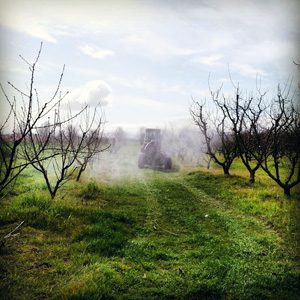This Week's Fruit
Hass Avocados
Stehly Farms Organics, Valley Center, CA
Creamy in texture, nutty in flavor, with a small to medium seed. The Hass skin is easy to peel and darkens from green to purplish-black as it ripens. You can tell it is ripe by the color of the skin (dark) and if it yields to pressure.
Pink Lady Apples & Fuji Apples
Cayuma Orchards, New Cayuma, CA
A cross between the Golden Delicious and Lady Williams, the Pink Lady is a crisp and juicy apple with a tart finish. A creamy white colored flesh that resists browning makes this an excellent apple for salads and slicing. Also a modern day favorite for eating out of hand. A cross between the Golden Delicious and Lady Williams, the Pink Lady is a crisp and juicy apple with a tart finish. A creamy white colored flesh that resists browning makes this an excellent apple for salads and slicing. Also a modern day favorite for eating out of hand. Fujis are a cross between Red Delicious and Ralls Janet, an heirloom apple dating back to Thomas Jeffrson. Fujis are loved by many for their crisp, sweet, and juicy character.
Hayward Kiwi
Chiechi Farms, Live Oak, CA
Originally known as the Chinese gooseberry due to its Chinese orgins. Hawyward Wright, a New Zealand nurseryman propagated his plants by grafting and they eventually became the preferred cultivar of growers due to their sweet flavor and thin skin.
Navel Oranges
Olsen Organic Farms, Lindsay, CA
California Navel Oranges are considered to be the best Navels for eating out of hand. They have a thick skin that is easy to peel, are seedless, and have a meaty and sweet flesh that makes them a perfect snack. Navels are also great for juicing and cooking.
Taccoro Blood Oranges
A beautiful orange to deep red flesh is revealed when you slice open a Tarocco. The flesh of the blood orange is firmer and more dense than an orange and its flavor is a little more tart. These beauties sweeten and darken in color as the season progresses.
A Note from Farmer Al
Dear CSA Members,
These next three weeks are the most critical time of the year for Frog Hollow. The apricots are just now beginning to bloom, and the bloom time is “make it” or “break it” because apricots are highly susceptible to Brown Rot Blossom Blight. Brown Rot is a fungal disease caused by the presence of fungus spores which reside in dormancy on all the branches and buds of the trees and also the soil. They only become active when environmental conditions are optimal for their growth: rain and temperatures above 52 degrees. Their favorite food is soft plant tissue especially apricot blossoms.
I will never forget the scene of devastation in the year 2011. It had been a beautiful bloom on the apricots in late February that year with the 20 acres of creamy white blossoms in full bloom. Then, on the first weekend of March a warm tropical storm swept in from the mid-Pacific ocean, settled in and stayed for 3 days. By Wednesday these trees had literally turned black. There wasn’t a single living blossom to be found, so of course no fruit…a total crop failure.
Such an intense event not only destroyed the 2011 crop, but it also exponentially increased the brown rot fungal population on the trees and in the soil. Our response to this has been to heal the biological ecology of the orchard with compost and compost tea.

The strategy is simple: to overwhelm the brown rot populations with our fungal dominated compost.
Since this time last year we’ve spread about 12 tons per acre in all the apricot orchards, and last spring, sprayed compost tea several times.
This morning I started brewing our first 300 gallon batch of compost tea. This will be ready to use by tomorrow morning we will spray all apricots before this next storm rolls in on Tuesday morning.
Let’s all keep our fingers crossed and hope our compost strategies give us a bounty of apricots in 2013!

 The strategy is simple: to overwhelm the brown rot populations with our fungal dominated compost.
Since this time last year we’ve spread about 12 tons per acre in all the apricot orchards, and last spring, sprayed compost tea several times.
This morning I started brewing our first 300 gallon batch of compost tea. This will be ready to use by tomorrow morning we will spray all apricots before this next storm rolls in on Tuesday morning.
Let’s all keep our fingers crossed and hope our compost strategies give us a bounty of apricots in 2013!
The strategy is simple: to overwhelm the brown rot populations with our fungal dominated compost.
Since this time last year we’ve spread about 12 tons per acre in all the apricot orchards, and last spring, sprayed compost tea several times.
This morning I started brewing our first 300 gallon batch of compost tea. This will be ready to use by tomorrow morning we will spray all apricots before this next storm rolls in on Tuesday morning.
Let’s all keep our fingers crossed and hope our compost strategies give us a bounty of apricots in 2013!


